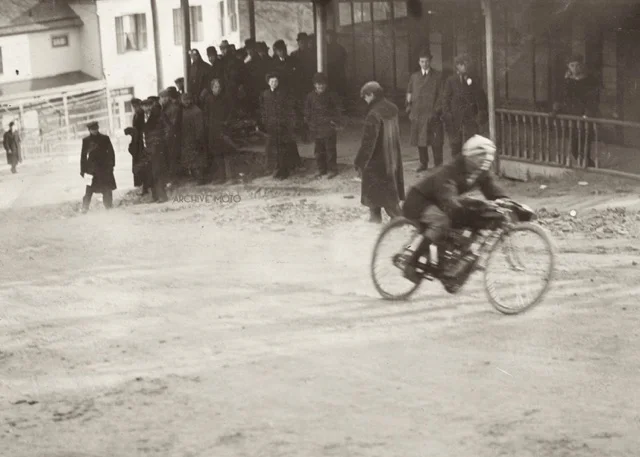A popular early form of motorsport was the hill climb, which in its original form dates back to the very introduction of the automobile and motorcycle.However, these early hill climbs were not the outlandish grudge matches with nearly vertical slants like the ones America fell in love with in the 1920’s and 30’s. The earlier bouts were timed ascents up inclined local roads throughout the country and were only slightly more civilized. This photo comes from one such early hill climb, an event staged in the palisades of New Jersey in the fall of 1909, just across today’s George Washington bridge from New York. Organized by the Edgewood Automobile Association, the hill climb was initially scheduled for Thanksgiving Day, though due to poor winter weather conditions the races were postponed until December 4th. The route was a 3,000 foot, twisty ascent up to the village of Fort Lee and boasted an average grade of 12 percent, though at its steepest was nearly 20 percent. Several auto classes were scheduled, as well as a single and a twin class for motorcycles. However, the crowd, unable to cure its own enthusiasm, grew too large and too eager for the local police to manage. As they jockeyed for the best position to watch the motorists fling their wide open machines around the treacherous corners, they spilled off of porches and into the street, gradually narrowing the route. The event’s officials were forced to act, terminating the event halfway through before anyone was seriously injured.
Unfortunately, the cancelation came midway though the twin cylinder motorcycle event, though by that point in the day the single cylinder racers, as well as a number of automobile classes had already made passes. A youthful newcomer from California, Reading Standard’s Ray Seymour was one of the few to get to complete both classes, placing second in the single event and making the fastest time of the twins to run in a time of 51.8 seconds, a speed of 39 mph. His teammate Harry Klebes had the closest call of the day as he ran his machine too fast around one of the final turns and found himself broadsiding the veranda of a local homeowner. Klebes’ Reading Standard twin was mangled but he managed to walk away relatively unscathed, though I’m sure the homeowner had a few choice words with the Philadelphian racer before the day’s end. The fastest auto of the day was a 40 HP National driven by John Aitken, who bested a field of Auburns, Buicks, Fords, Hudsons, Maxwells, and Renaults with a time of 56.57 seconds.
Captured in this photograph is American pioneer motorcycle champion Arthur G. Chapple during his lightening fast run in the single cylinder class, a run during which he set the best time of the day for any machine. One of America’s first factory sponsored professional racers, Chapple piloted his Indian 30.50ci single up the grade to Fort Lee in 50.15 seconds, an average speed of 41 mph, the fastest machine of the day on either two or four wheels. Chapple’s long running friend and Indian teammate Walter Goerke too was in the running for the hottest lap in the single event, but took a hard spill on the final turn. The pair were certain to set even faster times for the day in the twin class, their bread and butter, but it was just before their runs that the officials called the event for safety reasons. They would be allowed to return a week later, as were the remainder of the autos who were unable to run, but neither could get under young Ray Seymour’s twin cylinder time of 51.8 seconds, though Chapple came within two tenths of it. All three men would go onto to national acclaim in the sport, which at the time was surging in popularity. A.G. Chapple would later retire from racing only to become one of the leading advocates for the military effectiveness, preparedness, and participation of the country’s motorcycle enthusiasts in the years leading up to WWI.
Here is one of American motorcycle racing's founding fathers A.G. Chapple, a blurry apparition of speed, wide open onboard his Indian single, blasting past the ever-encroaching crowd during his chilly morning run up the Fort Lee Hill, December 4, 1909.


